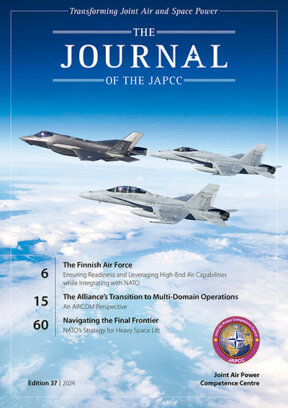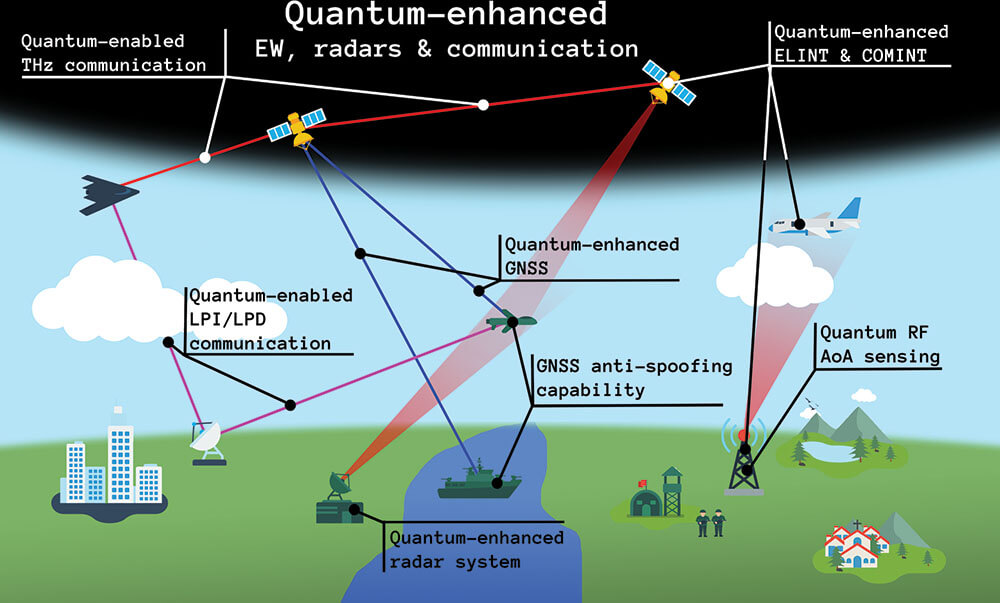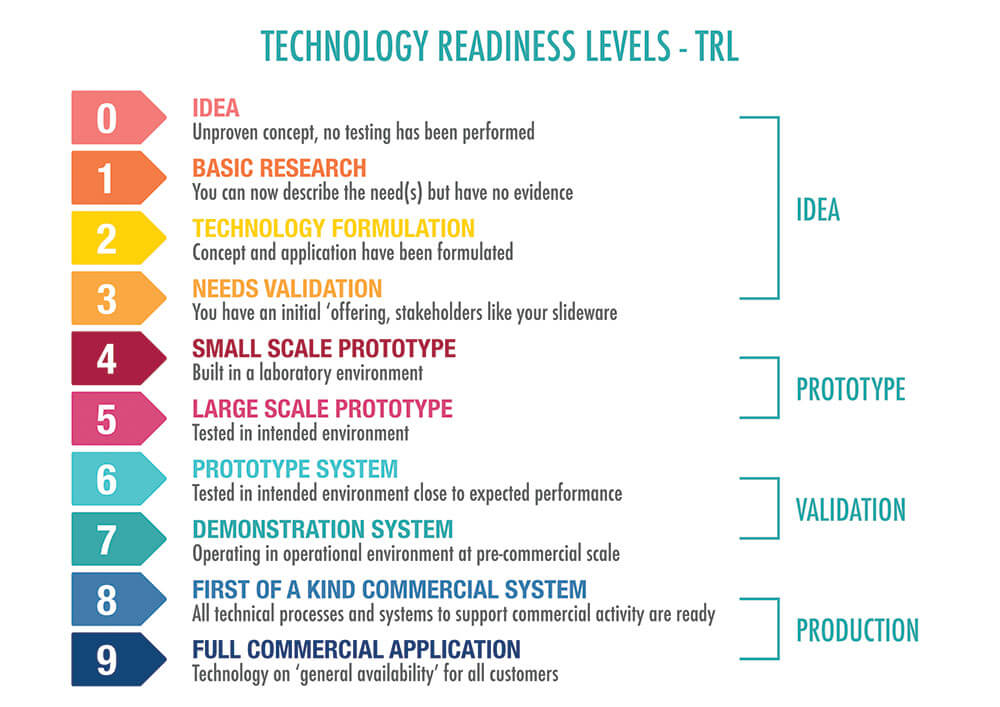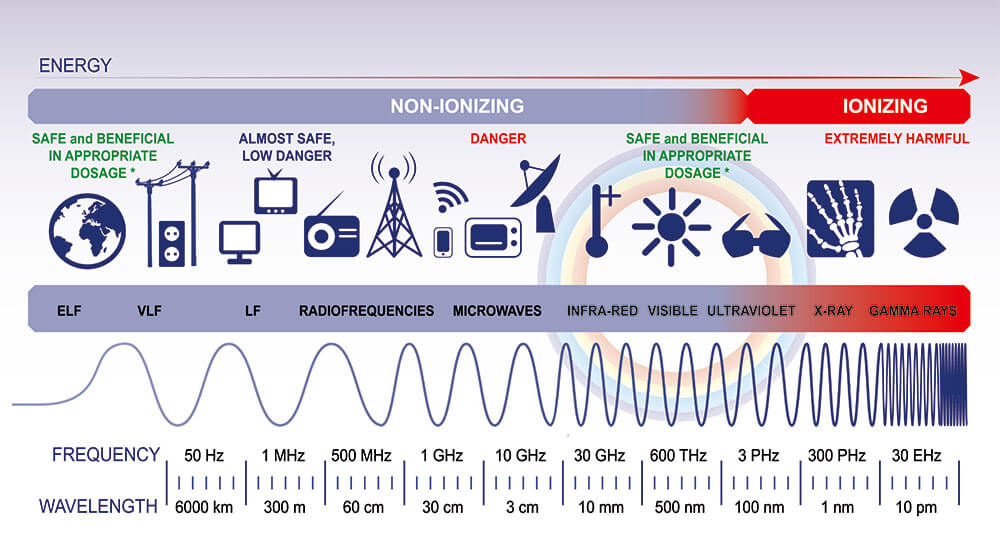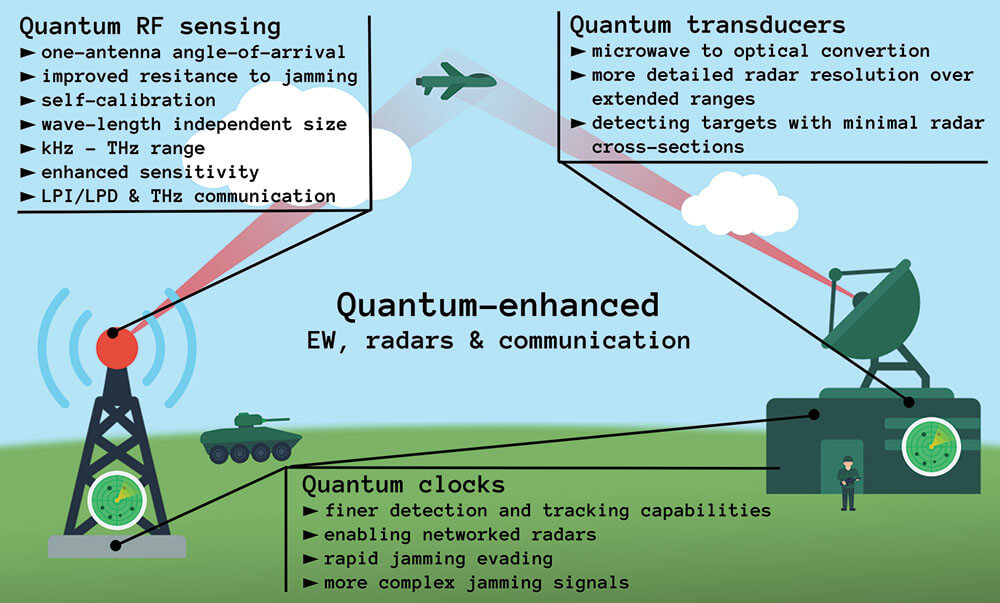Introduction
This article is the second instalment of a three-part series that delves into the realm of Quantum Technology (QT). Specifically, it explores the applications of this cutting-edge field within the military’s Air, Space, and Cyberspace domains. The article aims to shed light on the quantum technologies that hold promise for operational viability in the near to mid-term future.
Building upon the foundation laid in the previous article, titled ‘Quantum Technology for Defence – What to Expect for the Air and Space Domains,’ published in the JAPCC Journal 35 Winter edition, we now embark on a deeper exploration of this captivating subject. In our initial piece, we introduced readers to the second quantum revolution, providing a comprehensive overview of the fundamental theory and concepts of QT. Additionally, we highlighted three fundamental applications of QT, namely quantum computing, quantum networks and communication, and quantum sensing and imaging. Our aim was to dispel any misconceptions and help our readers establish realistic expectations for this burgeoning field. Now, in part two, we will delve into the intricacies of quantum-enhanced radar and electronic warfare, unravelling their complexities and shedding light on their potential implications.
As quantum technology matures, we can expect application across all domains, with potentially disruptive effect. © Copyrighted
QT is a young and dynamic field that harnesses quantum properties like superposition and entanglement at the fundamental level of individual quantum systems, such as electrons, ions, and atoms. With significant potential in military applications, many quantum technologies are particularly relevant to the air and space domains. Even long before quantum technology became a buzzword, institutions like Defense Advanced Research Projects Agency (DARPA) recognized its potential, supporting research that has now come to fruition.
Let us revisit the three primary applications for QT. Quantum computing, though the most publicized, is expected to significantly impact civil, defence, and security sectors on a more distant timescale of 10-20 years. Quantum communication, envisaged to become more relevant and applicable around 2030, promises secure and efficient data transmission. However, quantum sensing and imaging currently stand out for their immediate readiness, high interest, and profound near-to-medium-term military impact.
NATO has adopted the Technology Readiness Level (TRL) method of organizing technologies by maturity. © Dimitrios Karamitros/Shutterstock.com
The average Technology Readiness Level (TRL) for quantum sensing systems ranges from 3 to 9, indicating that these systems have moved beyond basic laboratory testing and are demonstrating impressive results. Efforts are now concentrated on transitioning from laboratory environments to real-world applications while simultaneously reducing size, weight, power, and cost (SWaP-C) parameters. Recent years have seen significant demonstrations aboard ships, aircraft, and drones. Advances in integrated photonics, including integrating laser sources and miniaturizing vacuum chambers and atom/ion traps, are accelerating this transition, potentially hastening deployment.
In this paper, we delve into a detailed examination of several of the most impactful quantum technologies with a near-to-medium-term horizon. Each technology will be introduced with a brief overview of its workings, followed by an analysis of its advantages over current counterparts. We will then explore specific military applications, with a focus on the air and space domains, and conclude with projections on time expectations for these groundbreaking technologies.
Quantum Applications show great promise across the electromagnetic spectrum. © Polina Kudelkina/Shutterstock.com
Quantum-Enhanced Radars and Electronic Warfare
Quantum Radio-Frequency (RF) Sensing
Introduction: Quantum technology offers several promising approaches for RF sensing. Two notable technologies are those based on Rydberg atoms and Nitrogen-Vacancy (NV) centres, both applicable for narrow and wideband RF scanning and reception.
Rydberg atoms involve exciting an inner electron to high energy levels using finely-tuned lasers, turning the atom into a highly sensitive electric dipole. This sensitivity allows the atom to respond to specific RF signals based on the electron’s energy level. The external RF field causes the electron to deexcite, emitting a photon in the optical domain for detection. The typical bandwidth of this method is around 10 MHz, indicating the potential need for a matrix of Rydberg-based sensors for wideband sensing.
Nitrogen-vacancy centres in diamonds are artificial defects in a diamond crystal lattice, formed by a nitrogen atom adjacent to a vacant lattice site. This structure yields a unique electronic state with an unpaired electron that can be manipulated and read. When a static magnetic field gradient is applied, the NV centres become sensitive to RF fields. Changes in the RF field affect the resonance in fluorescence, which is detectable optically. Unlike Rydberg-based technology, NV centres can handle bandwidths ranging from hundreds of MHz to a few GHz, depending on the magnetic field strength and gradient.
Advantage: Both technologies offer high sensitivity to electric (RF) fields, improved resistance to interference and jamming, self-calibration capabilities, and small sensor sizes (micrometres, irrespective of the measured wavelength).1 They also boast broad tunability (from hundreds of kHz to hundreds of GHz) and resistance to strong electromagnetic (EM) pulses. Outputting in the optical regime allows for faster signal processing compared to traditional RF electronics. Both can operate at room temperature, though cooling can enhance sensitivity.
Their phase detection sensitivity is particularly noteworthy, enabling angle-of-arrival (AoA) estimates from sensors a few centimetres apart or even within one sensor.2Lest we get lost in the technical details, the practical application is profound: Accurate AoA measurement is essential for Electronic Warfare (EW) applications. Whereas traditional AoA measurement requires multiple sensors separated by larger distances for adequate accuracy, a quantum sensor can measure angle of arrival within 2° from sensors within centimetres of one another. This accuracy, combined with much smaller space requirements, opens many possibilities for hosting sensors on satellites, small UAVs, and many other platforms.
Applications: These technologies are suitable for wideband scanning, such as Signals Intelligence (SIGINT) and Communications Intelligence (COMINT). Rydberg-based sensors can form phase-sensitive arrays,with each sensor tuned to different frequencies for angle-of-arrival estimation.3 NV centres, meanwhile, can function as a single sensor, although measuring higher frequencies requires stronger magnetic fields of around 1 Tesla for 30 GHz.4 In comparison, an early generation magnetic resonance imager (MRI) in a hospital has about a 1T field. Fortunately, small electromagnets or permanent neodymium magnets can create such fields at the scale necessary for quantum applications, making practical deployment feasible. These quantum-enhanced EW units are versatile and suitable for deployment in jets, space surveillance, or as passive radar replacements/enhancements.
There’s growing interest in Terahertz technology, which operates between 0.3 and 3 THz between the infrared and microwave regions, for new radar and communication applications. The Terahertz range offers very high data transfer rates with an estimated maximum of around 100 Gbit/s at 0.3 THz and unveils unique spectral patterns during material scanning in the THz range. Antenna sizes are small, but the detection range is short – just tens of metres due to strong atmospheric absorption. Fortunately, this limitation is not present at very high altitudes or in space. Rydberg-based sensors could be ideal receivers for such applications.5 Moreover, narrow-band Rydberg-based RF sensing could simplify radar or communication receiver systems, applicable in LPI/LPD communication or future 6G technology.6
Prognosis: The initial deployment of quantum RF sensing technologies is anticipated to be ground-based, with ongoing research focusing on miniaturization for airborne and space applications. We expect these technologies to reach an initial field capability within three or more years.
Recent achievements in quantum RF sensing underscore this rapid progression. For example, Quantum Apertures, a project led by Honeywell, is developing a programmable wideband Rydberg-based sensor through DARPA.7 This sensor demonstrates impressive capabilities, covering a frequency range from 10 MHz to 40 GHz, with a sensitivity of tens of – nV.cm-2.Hz-1, a one or two-order of-magnitude improvement over traditional systems. Such advancements can potentially free up the crowded frequency spectrum and create the possibility of a whole new generation of frequency-hopping communications. The project started in 2021 and is expected to continue through 2026, showcasing the potential for these technologies in various applications. Furthermore, British Telecom (BT) has conducted notable tests in the context of 5G and IoT (Internet of Things) technologies.8
Quantum Clocks
Introduction: Quantum clocks, especially those based on optical lattice and trapped ion technologies, mark a substantial leap over traditional atomic clocks, entering the realm of ultra-high-precision timekeeping. Optical lattice clocks function by trapping atoms within a grid of laser beams, forming a lattice that maintains the atoms in a consistent environment, free from outside disturbances, such as the motion of adjacent atoms. This setup allows the atoms to oscillate at optical frequencies (~1015 Hz), which are significantly higher and more precise than the microwave frequencies (~109 Hz) used in conventional atomic clocks.
Quantum logic clocks, on the other hand, confine single aluminium ions in electromagnetic traps. They utilize aluminium spectroscopy ions paired with a logic atom, typically magnesium. These clocks work by comparing the frequency of the two ion’s vibrations after hitting it with a laser. The paired atom is then used to detect these vibrations (aluminium is exceptionally stable but has difficulty detecting its state). In terms of performance, optical lattice clocks excel in stability, while quantum logic clocks offer superior precision.
Advantage: Quantum clocks surpass traditional atomic clocks in precision and accuracy. The quantum logic clock, for instance, achieved a fractional frequency inaccuracy of merely 9.4 × 10-19 as of 2019.9 This translates to a time deviation of only one second over more than 33 billion years, which is approximately three orders of magnitude more accurate than atomic fountain clocks.
Applications: Quantum clocks have two primary applications. Firstly, they are used for the distribution of precise time, such as in Global Navigation Satellite Systems (GNSS) like GPS. Secondly, portable, albeit less precise, quantum clocks are used for local measurements. One may still rightly ask why such extreme precision is useful. Such precise timing is crucial for various quantum sensing and measurement systems, ranging from quantum gravimetry and magnetometry to quantum inertial navigation and computing. Moreover, their enhanced precision can significantly benefit classical radar and electronic warfare systems.
Applications for Quantum Technology go far beyond quantum computing; quantum-enhanced devices have the potential to greatly advance capability while reducing vulnerabilities. © Copyrighted
For instance, GPS is accurate to less than 40 nanoseconds relative to Coordinated Universal Time (UTC); quantum clocks could refine this to the picosecond level. Additionally, incorporating a local atomic clock in GNSS receivers could bolster anti-spoofing capabilities.10
In radar systems, the extraordinary precision of quantum clocks allows for much finer detection and tracking capabilities. This is essential for identifying small, slow-moving objects, such as drones, at longer distances and even in cluttered environments.11 Precise timing is also crucial for networked radars which combine multiple radar pictures in real time.12
For electronic warfare, integrating quantum clocks could transform communication and jamming strategies. Their ultra-precise timing enables military forces to rapidly change frequencies, evading enemy jamming. They also facilitate the transmission of more complex jamming signals to disrupt enemy communications or other EM signals. Furthermore, quantum clocks can be integrated into various military assets, enhancing accuracy and effectiveness.13
Prognosis: Quantum clocks are currently in the experimental stage, with ongoing development and refinement in labs. The transition to military deployment is expected to take some time, with commercial or military applications anticipated within the next few years. Experts are working on miniaturizing these clocks for integration into diverse military platforms, envisioning them to be compact enough for use in missile warheads, small drones, or electronic warfare pods on fighter jet.14 For the air and space domain, the quantum clock could be relevant in 5 – 10 years. For example, optical clocks with a precision (relative uncertainty) of 10-11 within the 3U15 package are already commercially available.16
Quantum Transducers
Introduction: Transduction refers to converging energy from one form to another, such as antennae, microphones, and accelerometers. However, microwave-to-optical signal conversion is a transduction process that is just now available thanks to quantum transducers, which are pivotal in transferring (quantum) information from the microwave domain to the optical regime. These transducers employ various mechanisms, such as electro-optical and magneto-optical devices, opto-mechanical structures, and atoms with appropriate energy level spacings, to facilitate coherent signal conversion. Recent progress has notably enhanced their efficiency and bandwidth. For example, efficiencies nearing 80% have been reported.17
Advantage: Converting microwave signals to optical frequencies via quantum transducers offers distinct advantages over traditional microwave signal processing. This conversion enables the mapping of information from a narrow-bandwidth microwave field to a broader optical frequency range. This capability is crucial for coherent frequency-division multiplexing (FDM), which enables the simultaneous processing of multiple signals within the optical domain rather than relying on several parallel microwave channels. This leads to improved efficiency in complex signal-processing tasks.18
An additional advantage relates to environmental influences. At room temperature, the optical domain is characterized by minimal photons from thermal noise. This is a significant advantage over microwave frequencies, where thermal-photon occupation can introduce noise in signals. Optical domain systems have also shown proficiency in phase-correlated amplitude control of the multi-channel optical field, akin to a frequency domain beam splitter. This enables precise control over specific frequency channels, facilitating rapid filtering, signal processing, and more efficient digitalization.
Applications: In radar technology, quantum transducers can substantially enhance performance. By converting microwave signals to optical frequencies, these transducers allow radar systems to achieve greater sensitivity, particularly in detecting targets with minimal radar cross-sections and weak return signals. Optical frequencies provide wider bandwidths and higher frequencies, resulting in more detailed radar resolution over extended ranges.19
Quantum Transducers have applications across the spectrum of radar receivers, including in photonic-microwave radars, electronic warfare systems, and remote sensing and surveillance. The amalgamation of microwave robustness and optical frequency resolution significantly bolsters the capabilities of various sensing technologies, essential for the next generation of comprehensive surveillance and intelligence gathering.
Time Expectations: Integrating quantum transducers into military applications is anticipated to be progressive. With current advancements in quantum technology, we can expect prototypes to emerge within the next five years. For instance, the development of integrated quantum transducers for quantum computing applications is already underway.20
Conclusions
This article delves into the realm of quantum technologies, highlighting their expanding significance and immense potential within the military domain, specifically in the areas of radars and electronic warfare for air and space operations. Quantum sensors already show high levels of technological readiness, and their application in diverse and challenging military environments appears close. These advancements are not just theoretical; practical demonstrations in real-world scenarios aboard ships, aircraft, and drones highlight the transition of these technologies from laboratory settings to operational fields. Such advancements will also be further examined in the third article in this series, focusing on intelligence, surveillance, and reconnaissance (ISR), and positioning, navigation, and timing (PNT).

